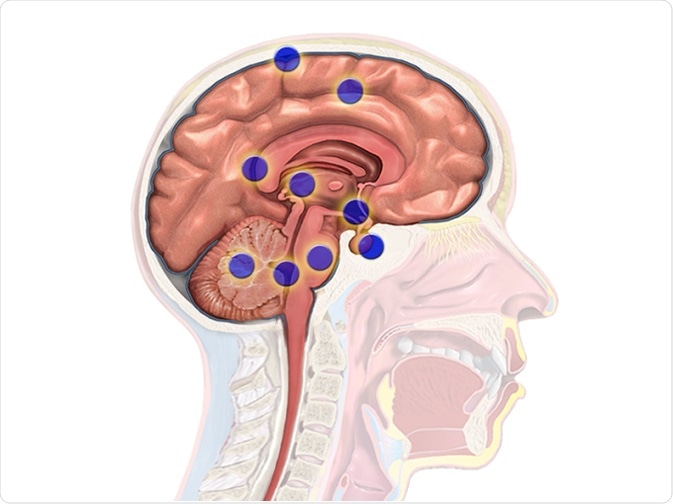
Secondary Brain Cancer
Cancers such as breast cancer, lung cancer, kidney cancer, bowel cancer, and melanoma skin cancer can spread to the brain causing secondary brain cancer, which is approximately 10 times more frequent compared to primary brain cancer. The cerebral cortex is the high risk area where secondary brain tumors develop, while 15% of secondary brain tumors develop in the cerebellum and 5% develop in the stem of the brain. In the US, approximately 100,000 individuals are diagnosed with secondary brain cancer annually.

IMAGE: Bain Cancer Regions. ©BruceBlaus/ commons.wikimedia.org
Symptoms
The human body is controlled by different parts of the brain. Depending on the position of the tumor and the pressure it exerts on the brain, symptoms may vary. The presence of a tumor in the brain increases the intracranial pressure (ICP). Some of the symptoms due to ICP are listed below.
Patients may feel drowsy, sick, and confused, may have blackouts and fits, and may experience headache, which may be worst in the early hours of the day. Other symptoms include unsteadiness, weakness in the face and one side of the body, and loss of eye sight and smelling abilities. Stiffness in the neck, flickering of the eyes and uncoordinated movements are also part of this list of symptoms. Other signs of a brain tumor may include difficulty in remembering and doing calculations and difficulty in speaking, writing, reading, and swallowing, as well as a change in behavior/personality.
The above symptoms may also be due to primary brain cancer or any other medical condition.
Diagnosis
Physicians suggest the type of test based on the symptoms diagnosed in their patients.
Along with blood tests and chest X-rays, scans such as MRI, PET, and CT scans are also suggested. Special tests such as angiogram, biopsy, and EEG are also available for detecting secondary brain cancer.
The electrical activity of the brain is recorded using the EEG test and this test is recommended when the patients have seizures. When physicians suspect a tumor near a blood vessel, an angiogram is suggested.
Physicians make a burr hole in the skull and collect a small tissue sample (biopsy) using a needle. Brain scans assist in finding out the tumor location. The lab results are examined to determine treatment.
Spinal tap or lumbar puncture is done to measure the cerebral spinal fluid pressure and to also get a fluid sample. In rare situations, cisternal and ventricular puncture methods are used for collecting cerebral spinal fluid samples.
Treatment
Deciding on a secondary brain cancer treatmentis difficult as it is important to understand the type of treatment that suits a patient, the side effects, and the number of hospital visits required. Factors such as treatment that has been received earlier, type of primary cancer, number of tumors present in the brain, symptoms, general health of the patient, and whether the cancer extends to other organs all need to be considered before deciding on the treatment.
While secondary brain cancer cannot be cured, treatments can help in controlling the cancer and improving the quality of life of the patients.
In chemotherapy, drugs are used for controlling or treating cancer. In some patients, this treatment reduces the tumor size, delays the onset of symptoms, or controls the symptoms. Usually two to three drugs are combined together and injected into the blood or cerebrospinal fluid or patients consume them in the form of tablets. Physicians decide on the chemotherapy type and dosages and suggest whether they can be given to patients before or after radiotherapy or surgery.
While using radiotherapy, the tumors are targeted using high-energy rays. These rays destroy or reduce the cancer cells. To ensure that the therapy covers large areas of the brain or the brain as a whole, the external radiotherapy treatment duration is more than a week or two.
Considering the risk possibilities of development of other secondary tumors, physicians will recommend treatment for the whole brain. If risks are higher for whole brain treatment, targeted radiotherapy such as stereotactic treatment is recommended. Yet this is possible when the size of the secondary brain tumor is small and the number of tumors is slight, say, just one or two in the brain.
For reducing swellings, anti-inflammatory drugs (steroids) are recommended. In addition, when the first diagnosis is secondary brain cancer, then steroids can be used. Physicians may slowly reduce the dosage of drugs as these steroids control the symptoms. Anti-epileptic drugs are prescribed for preventing seizures.
Surgery may be suggested when physicians diagnose only one secondary brain tumor in the patients. When the tumor is widely spread across the brain, then surgery is not a possible treatment. Secondary brain tumors are removed in the same way as the primary tumors.
Depending on the treatment type and duration, drug dosage, and health of the patient, side effects, such as loss of appetite, a feeling of sickness, loss of hair, diarrhea, and fatigue, may arise. However, the aim of the treatment is to control symptoms and cure cancer. Therefore, physicians will consider using drugs and dosages that balance both cancer control and side effects.
Sources
- https://www.cancer.ie/cancer-information/secondary-brain-cancer#sthash.E7NFPFlD.dpbs
- https://www.cancer.ie/cancer-information/secondary-brain-cancer/symptoms-and-diagnosis#sthash.KZVABgWY.dpbs
- https://www.cancer.ie/cancer-information/secondary-brain-cancer/treatment#sthash.qm1aliT0.dpbs
- http://www.cancerresearchuk.org/about-cancer/secondary-cancer/secondary-brain-cancer/treatment
- http://www.macmillan.org.uk/information-and-support/brain-tumours-secondary#155664
- http://www.christie.nhs.uk/patients-and-visitors/your-treatment-and-care/types-of-cancer/secondary-brain-tumours/
- https://medlineplus.gov/ency/article/000769.htm
- https://medlineplus.gov/ency/article/003428.htm
- https://www.mskcc.org/cancer-care/types/brain-tumors-metastatic
Further Reading
Last Updated: Feb 26, 2019





















.png)










No hay comentarios:
Publicar un comentario